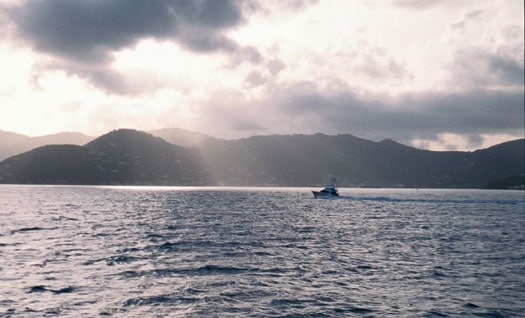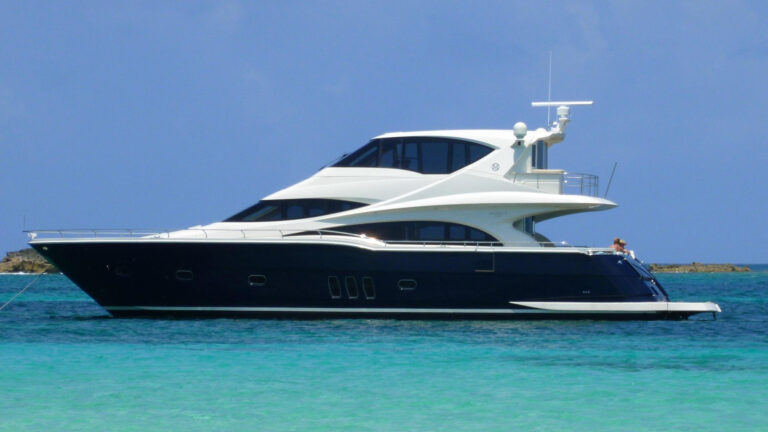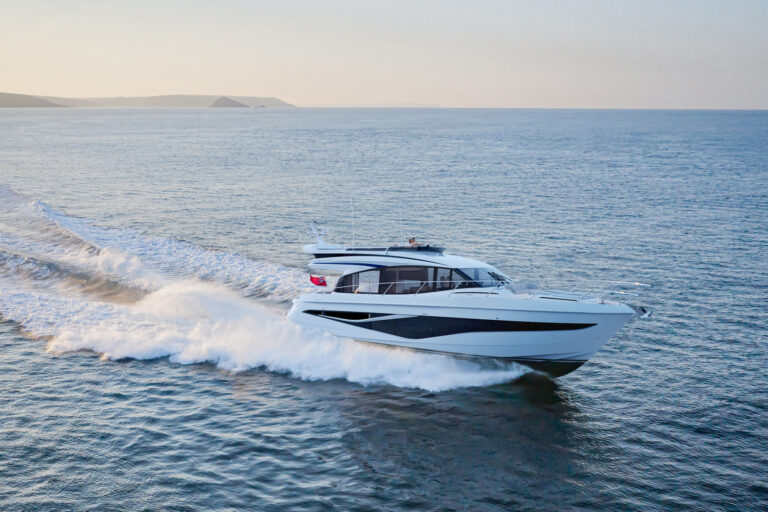
yachting/images/magazine/2007/072007/yl_cruising_525x318.jpg
Remember your first time? Anyone who’s caught a big blue marlin certainly does. As only female blue marlin grow larger than about 300 pounds, it’s not even sexist to say it. The great thing about big blues is this: When the outrigger clip snaps open and the line comes tight, and the captain who saw the bite is yelling “blue marlin, blue marlin,” no one is quite sure how big the fish is-until her first jump, greyhounding across the surface at 40 miles per hour.
The world’s largest game fish, and for their size by far the fastest and most agile, blue marlin are always a thrill to catch. And if you’ve never experienced the heart-racing, spine-tingling, heightened sensation of having a big blue, summertime in the Virgin Islands may be your best chance for hooking up.
With billfish, the chase is half the battle, but trolling the right spot increases the odds for a quick first score. For large blue marlin, the North Drop is the place. Deep, nutrient-rich water from the Puerto Rico Trench-at 28,000 feet the deepest spot in the Atlantic-flows upward to the shallow water just a few miles north of the Virgin Islands, providing plenty of food for the bottom end of the food chain as well as for apex predators like marlin. This is why serious fisherman flock to St. Thomas around the first full moon in August-the hottest blue marlin bite in the Atlantic.
But therein lies an irony. The North Drop is actually within the waters of the British Virgin Islands, not the USVI. The sport boats collect in St. Thomas simply because it is where the other “serious” fishermen are. This presents an unusual opportunity to resolve any family tensions and maybe turn your quest into a holiday for everyone, because if you are into fishing but not really into fishermen, you can choose to relax at the slower pace of “the other” Virgin Islands-the ones with the posh accents.
In fact, the ESPN-televised Billfishing Xtreme Release League tournament series stops in Tortola, the largest island in the BVI, rather than St. Thomas.
“The whole sportfishing world goes to St. Thomas in the summertime. If you do get a slip, you’d better keep it-you’re not going to get it back,” says Mike Gautreaux, executive director of the BXRL series. The same is true of hotel rooms and restaurants, which leads to logistical problems for Gautreaux, with 60 anglers, a dozen each of cameramen and judges, plus support staff. And yet, “If you just go right across to the BVI, they’re generally empty. Tortola is known as a sailing destination. They’re busiest in the winter. In the summer-the peak blue marlin season-they’re wide open and eager to have sportfishermen.”
You’d better plan ahead for fishing in the BVI, because if you need marlin tackle, the closest place may be back in St. Thomas. Ditto for experienced mates. “There isn’t as much to do in Tortola. The really great restaurants, the shopping, are in St. Thomas,” says Dick Tanner, BXRL’s tournament director. This is not necessarily a bad thing, however. “You’re not in a crowd in Tortola. If you want to find a nice quiet beach or a secluded anchorage, BVI is the place.”
It isn’t the sportfishing set that causes crowding, Gautreaux and Tanner agree; it’s the cruise industry in St. Thomas. With shops and restaurants catering to passengers of two or three cruise ships at a time, it’s a mass-marketing game in which it’s easy to ignore private yachtsmen.
When I was in Tortola last July for the BXRL tournament, I taxied to Road Town for the Emancipation Festival, an annual three-week celebration of the August 1, 1834, Emancipation Act abolishing slavery in the British West Indies. This Caribbean version of a county fair includes daytime parades as well as nighttime amusement park rides and carnival games, live music and local food. There was plenty of local rum served at the festival, but this didn’t hinder the family atmosphere; I even got used to seeing kids begging their parents for more cotton candy or snow cones while Mom and Dad were refreshing their Cuba Libres at the very same booth. As a reminder of the Christian roots of reggae, not often emphasized back in the U.S.A., vendors displaying Bob Marley paraphernalia also sold plaques of the Psalms. Emancipation Day comes across as a concoction that is equal parts culture, religion and civil rights, with a distinct emphasis on civility.
This civility, laid-back in all respects, percolates through the islands, even in Road Town, the capital of the British Virgin Islands. The city offers plenty of shopping and nightlife year-round, though without the duty-free incentives of the USVI or the caliber of shops and restaurants supported by St. Thomas’s one million cruise ship passengers per year.
As for marinas in the BVI, these once were a bit “rustic” compared with their USVI counterparts, but all is changing rapidly. The BXRL fleet bases itself at Nanny Cay, a picturesque marina just a $6 taxi ride west of Road Town. After 10 years in receivership with bare-minimum maintenance, a group of Scottish investors bought the facility in 2000, making steady improvements such as modern floating docks, ample electric, including 100-amp three-phase power on the T-heads, and free wireless Internet. “Our long-term goal is to be the finest marine facility in the Caribbean,” says Miles Sutherland Pilch, Nanny Cay’s marina manager. “We’re currently about halfway through our game plan.”
On a low-lying spit of land nestled between two mountains, Nanny Cay currently offers 180 slips, two restaurants, a 40-room hotel and numerous shops, including a full-service dive operation and a well-stocked chandlery. The boat yard, at the shoreside end of the marina, boasts a 70-ton travel lift and a host of repair facilities. Future plans call for a yacht club, 32 waterfront townhomes and five villas, which will be privately owned but made available to rent. For unattended yachts, the boat yard offers hurricane cradles anchored into the ground for long-term out-of-water storage.
While Tortola’s marlin fishing is still something of a secret, its reputation as a cruising paradise is not, given protected waters providing easy travel to nearby Virgin Gorda, Jost Van Dyke and the U.S. Virgin Islands. But the one island you should acquaint yourself with is Anegada, the northernmost of the British Virgin group and the only large coral island in the archipelago. Only 28 feet above sea level and lacking the rainfall and fresh water of her otherwise lush British Virgin sisters, Anegada is best known for 18 miles of reef just yards off its 16 miles of beautiful sandy beach; but the island also is barely a mile from Anegada Drop, which, like the North Drop a few miles west, produces five to 10 shots at blue marlin per day. And while St. Thomas fishermen have to register for BVI fishing permits to troll either the North Drop or Anegada Drop, Tortola-based boats can forgo the paperwork and are free to land at Anegada after fighting a few marlin, for the island’s most famous attraction: lobster barbecued and served beachside. (The reef entrance, once tricky, is now well marked, and while the dock at Anegada Reef Hotel can handle only one or two boats to 50 feet, it’s much nicer to moor out, anyway.)
If you prefer to eat what you catch, BVI offers abundant wahoo, yellowfin tuna and dorado (my preferred name for the species, as I insist that mahi-mahi only exist in the Pacific). Bonefishing is good too, and billfish are caught year-round. The Virgin Islands also lay close to the South Drop that falls 12,000 feet to the Caribbean Sea floor. Since billfish migrate largely because of sea temperature, with different species favoring different temperatures, being on the edge of both a subtropical ocean and a tropical sea adds to the possibilities. Sailfish season in the wintertime fades into white marlin as the water warms, and the blue marlin finally begin to make their appearance as early as May.
For the true summertime blues, however, schedule your trip from 10 days before to a week after the full moon in July, August or September. Why the full moon, when in many locales blue marlin are said to bite on the new moon? We’ll leave that to you to find out, on your next trip to Tortola.









